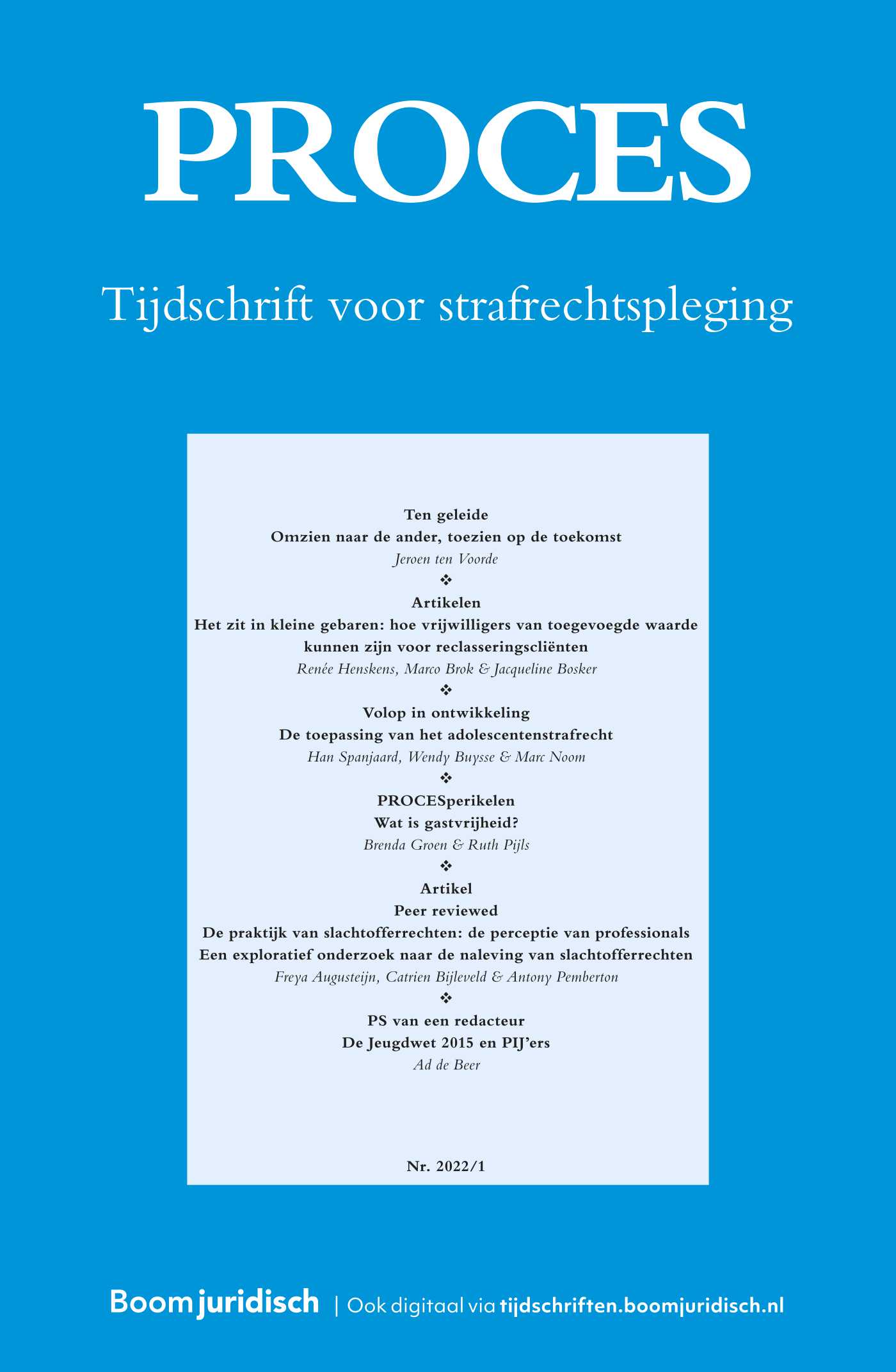|
|


PROCES
Meer op het gebied van Criminologie en veiligheid
Over dit tijdschriftMeld u zich hier aan voor de attendering op dit tijdschrift zodat u direct een mail ontvangt als er een nieuw digitaal nummer is verschenen en u de artikelen online kunt lezen.
| Redactioneel |
Tuigdorpen, straatterroristen en straattuig: mag het wat minder in 2012? |
| Trefwoorden | Editorial |
| Auteurs | Mr. dr. Jolande uit Beijerse |
| SamenvattingAuteursinformatie |
| Artikel |
Intelligencegestuurd politie(mensen)werk |
| Trefwoorden | Intelligence Led Policing, information, communication, safety analysis |
| Auteurs | Drs. Paul Duijn |
| SamenvattingAuteursinformatie |
|
In order to control problems of public safety the police have to respond proactively on potential threats. Analyzed information and knowledge (intelligence) is therefore needed to give direction to police work on strategic, operational and tactical police management levels. This principle is called Intelligence Led Policing (ILP), with its main goal to become a more effective police organization. Critics point at bureaucratization processes that go along with the implementation of ILP. In this paper the importance human interaction in relation to ILP is discussed as a key factor in preventing these bureaucratization processes. Direct interaction between information collectors, intelligence analysts and decision makers is a necessary ingredient in order to become an effective intelligence led police organization. |
| Artikel |
Bedreiging van burgers en de grenzen van het strafrecht |
| Trefwoorden | violence, police reports, victim accounts, criminal law |
| Auteurs | Drs. Bert Bieleman, Prof. dr. Willem de Haan, Dr. Jan Nijboer e.a. |
| SamenvattingAuteursinformatie |
|
The rise in criminal violence in the Netherlands tends to be explained by the increase of reported threats of violence, in particular in the domestic and neighborhood context. In order to better understand this increase, we analyzed a sample of police reports, interviewed victims and talked to professionals within the police force, the prosecution office and professional help agencies. We found that, in many cases, victims who reported threats with violence to the police were disappointed by the results. Reasons for their disappointment can be accounted by the nature of the offence and by the requirements of criminal law. Criminal justice does not, and, indeed, cannot, offer victims a satisfactory solution to their problems. To prevent their disappointment victims should, therefore, be made aware of the limits of criminal justice when they file their complaints with the police. |
| Praktijk |
De bilknijper |
| Auteurs | Mr. Rogier Hörchner |
| Auteursinformatie |
| Artikel |
Voorwaardelijke PIJ-maatregel of voorwaardelijke jeugddetentie?Een vergelijking van problematiek van de jeugdigen en invulling van de sancties |
| Trefwoorden | conditional juvenile detention, conditional PIJ-measure, change of behaviour, punishment |
| Auteurs | MSc Aniek Verwest |
| SamenvattingAuteursinformatie |
|
Juvenile detention and the custodial measure ‘institutional placement order’ (plaatsing in een inrichting voor jeugdigen; PIJ-measure) are often administered by the court under conditions at first. It is unknown to what extend it is possible to make a distinction between a punishment and a treatment measure looking at both conditional penalties. In order to gain more information about the differences and similarities between these conditional penalties, the verdicts of juvenile offenders have been studied. The study involves a group of juvenile offenders with a conditional PIJ-measure and a group of juvenile offenders with a conditional juvenile detention. The results reveal that there are considerable similarities between the two groups. The high prevalence of behavioural problems and disorders in the group juvenile offenders with a conditional juvenile detention is particularly notable. Conditional juvenile detention may include treatment of the behavioural problems and disorders, but if the conditional juvenile detention is transformed into unconditional juvenile detention there will be no individual and specific treatment of these disorders. |
| Artikel |
De gedragsbeïnvloedende werking van jeugdsanctiesEen vergelijking tussen het Nederlandse en Nieuw-Zeelandse jeugdstrafrecht |
| Trefwoorden | youth criminal law, New Zealand, influence on behavior, repeat offending |
| Auteurs | Mr. Sharony Droogendijk |
| SamenvattingAuteursinformatie |
|
To achieve effective outcomes in youth justice, youth criminal law should help influence youth criminal behavior and support the young persons development to maturity. In New-Zealand, youth criminal behavior is dealt with by Family Group Conferences according to the Children, Young Persons and Their Families Act. This way of dealing with youth criminal behavior supports the development of young persons and requires involvement of the young persons family and the victim. Research shows that conferencing in youth justice leads to less repeat offending. This supports the conclusion that Dutch youth justice should adopt the New-Zealand principles. |
| Artikel |
De levenslange gevangenisstraf, gratie en voorwaardelijke invrijheidstelling in rechtsvergelijkend perspectief |
| Trefwoorden | mandatory life sentence, parole, European Convention on Human Rights, comparative law |
| Auteurs | Mr. Wesley Welten |
| SamenvattingAuteursinformatie |
|
In the Netherlands, a person sentenced to life imprisonment (lifer) cannot be pardoned or paroled. This has led to debate. I have investigated if this impossibility also exists in other countries (Canada, England, Germany, Belgium). This article shows that in all the other countries studied, lifers can be pardoned after a certain period of time. A law comparative interpretation of article 3 ECHR would therefore lead to the conclusion that the current Dutch policy is contradictory to this article. The results in this article could contribute to the debate that has arisen in the Netherlands. |
| Column |
‘Get a map’ |
| Auteurs | Mr. Rob van Noort |
| SamenvattingAuteursinformatie |
|
Column |
